The Medicinal Benefits of Ashwagandha
Written by Meghan Gemma
Photography by Juliet Blankespoor
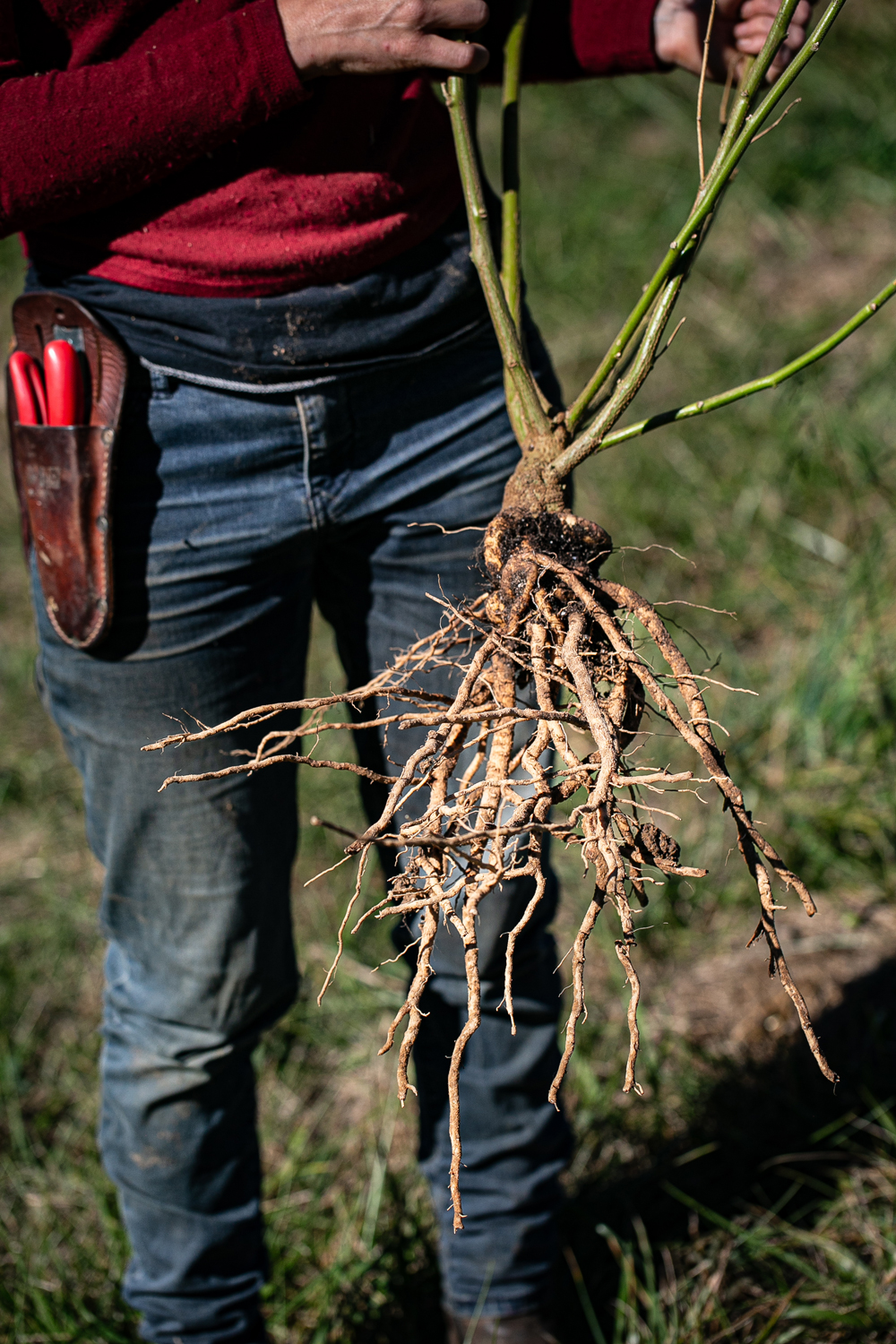
Ashwagandha’s pungent roots, which possess a notoriously musky aroma, can be profoundly renewing for your health.
If you experience overwhelm in your life—whether from insomnia, anxiety, or burning the candle at both ends—the medicinal benefits of ashwagandha bring many blessings. Ashwagandha calms and heals your nervous system, refreshes sleep cycles, invigorates immune resilience, and infuses your entire being with strength.
This charismatic herb heralds from India, the Middle East, and Northern Africa. Ashwagandha’s medicinal use in the Western world is thanks to the traditional healers of these regions, who cherish its healing root for countless ailments.
In this article, we’ll discuss the following (click to jump ahead):
Among herbs, only a venerated few are true vitality tonics and nourishing rasayana restoratives. Ashwagandha—whose name means ‘essence of the horse’—is one of these, and its medicine is revered in the ancient traditions of Ayurveda, Siddha, Unani, and Indian folk healing.
Its pungent roots, which possess a notoriously musky aroma, have been enthusiastically adopted by Western herbalists in recent years for their adaptogenic qualities. When taken over time, ashwagandha can be profoundly renewing for your health.
Ashwagandha’s medicine is calming, centering, and strengthening.
Psst…If herbal profiles like this tickle your botanical fancy, you’ll find more detailed monographs on our blog, including calendula, passionflower, pine, witch hazel, violet, goldenrod, and more.

Ashwagandha’s papery husks peeled back to reveal its fruit.
How to Identify Ashwagandha
Scientific Name: Withania somnifera
Botanical Family Name: Solanaceae, nightshade family
Other Common Names: Indian ginseng, winter cherry, asgandh (Hindi)
Range: Native to the drier regions of India, Sri Lanka, the Middle East, and northern Africa, ashwagandha has naturalized throughout southern Eurasia and many parts of Africa. It is now cultivated in temperate and subtropical climates around the world.
Botanical Characteristics: In its native range, ashwagandha is a small evergreen perennial with woody stems and a shrub-like appearance. In temperate regions, it grows as an annual in the herb garden. The leaves are softly silver-green, alternate, and elliptic, with glabrescent (smooth) surfaces and slightly hairy undersides. The star-shaped flowers are a subtle shade of yellow-green and give way to bright scarlet berries that ripen late in the season, earning ashwagandha the nickname “winter cherry.”
The fruits are encased in papery brown husks (the persisting remnants of the calyx) and resemble tiny tomatillos. Belowground, ashwagandha’s roots are cream-colored and fleshy, exuding a bracing scent when chopped or crushed.
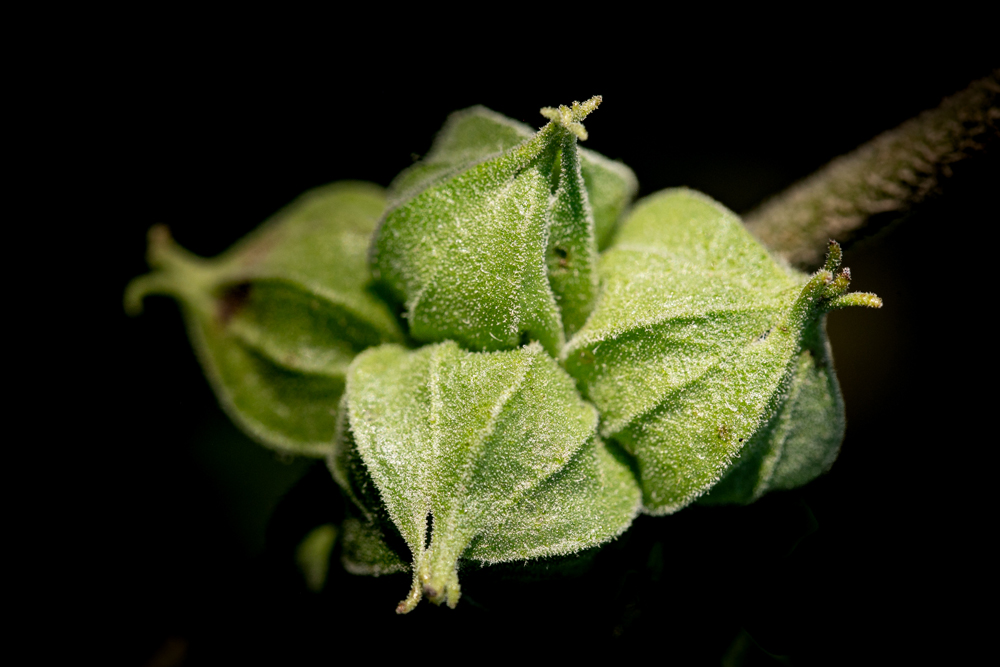
The developing fruit of an ashwagandha plant.
Culinary & Edible Uses of Ashwagandha
Ashwagandha’s roots possess a curious flavor—they’re pungent, nutty, and sometimes said to taste of malted milk balls. Traditionally (and less favorably), their scent has been likened to horse sweat. This comparison is unflattering, but don’t let it dissuade you from trying ashwagandha, which can be prepared in a number of delicious ways.
In Ayurveda, ashwagandha is classically powdered and paired with healthy fats, such as ghee or warmed whole milk with honey. The addition of cinnamon (Cinnamomum verum), cardamom (Elettaria cardamomum), and vanilla powder (Vanilla planifolia) is enticing to the taste buds. Try this Ashwagandha, Lavender, and Vanilla-Infused Ghee for a medicinal treat.
Ashwagandha can also be stirred into hot chocolate, blended into smoothies, or steeped with chai herbs. The powdered roots can be used to make adaptogenic snack balls when combined with ghee, ground toasted sesame seeds, nut butters, and/or other powdered herbs like shatavari (Asparagus racemosus) and eleuthero (Eleutherococcus senticosus).
You can even make cookies, like these adaptogenic snickerdoodles from Asia Suler of One Willow Apothecaries. Just substitute an equal amount of ashwagandha powder for the ginseng powder in her recipe.
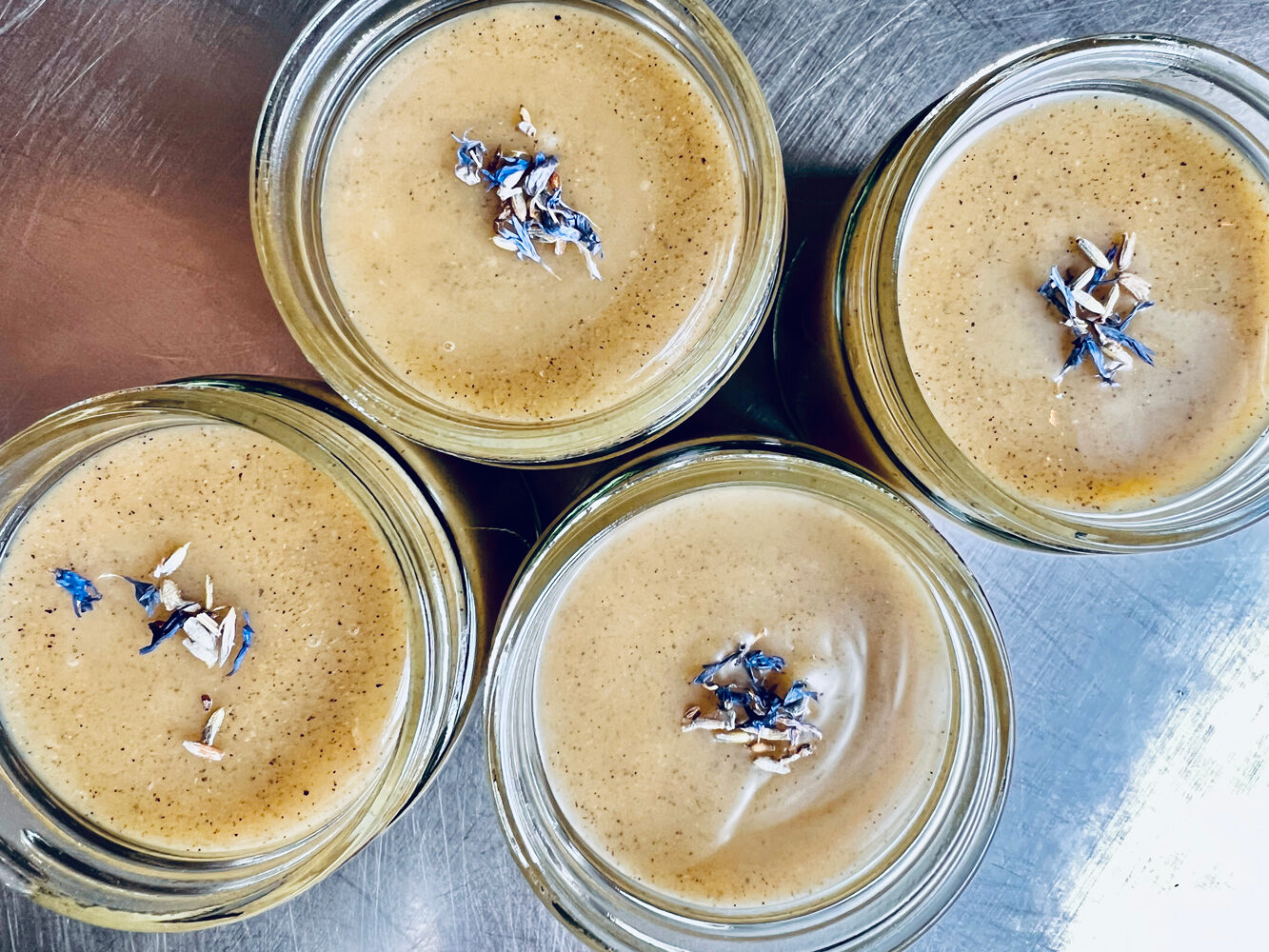
Ashwagandha, Lavender, and Vanilla Herbal-Infused Ghee. Try the recipe. Photograph courtesy of Goddess Ghee.
The Medicinal Benefits of Ashwagandha
Parts Used: Root
Preparations: Tea (decoction), tincture, powder, capsules, medicated ghee, infused milk, goo balls
Powder Dosage: 1-6 grams daily
Tincture Ratios and Dosage: Dry (1:4 60%) 2-4 ml up to three times per day (fresh root tincture not recommended due to high bioactivity)
Tea Ratios and Dosage: Decoct 1-2 teaspoons dried root per 1 cup water up to three times per day
Herbal Actions:
- Adaptogen
- Anxiolytic
- Anti-inflammatory
- Antioxidant
- Anti-tumor
- Aphrodisiac
- Immunomodulator
- Nervine
- Neuroprotective
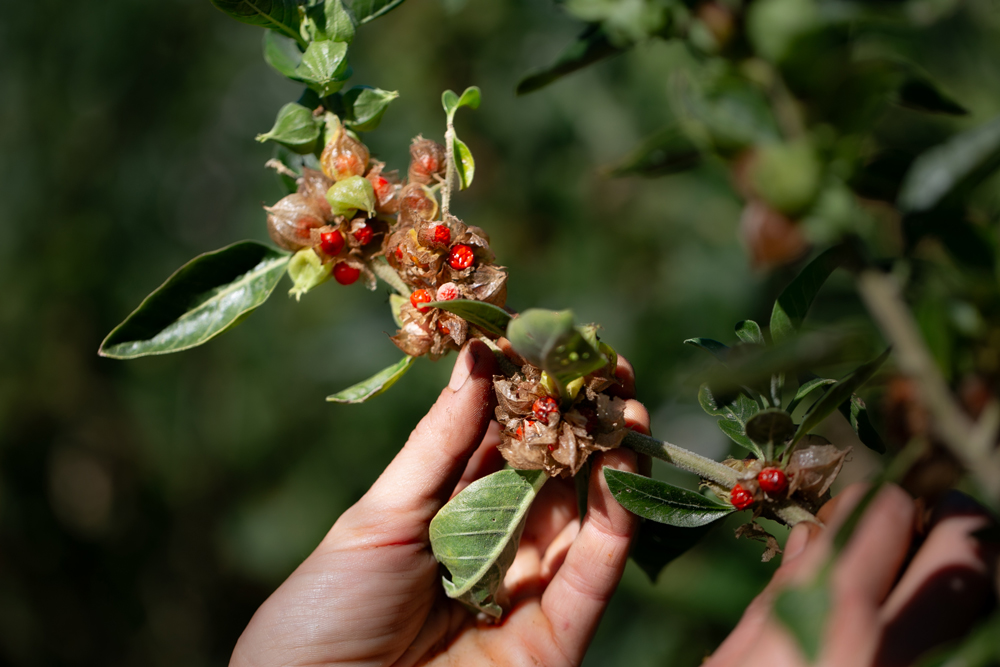
The developing fruit of an ashwagandha plant.
Ashwagandha is an ancient rasayana and adaptogenic herb that repairs the body from stress, anxiety, and insomnia.
An adaptogen and Ayurvedic rasayana, ashwagandha rejuvenates the body at the deepest levels and nurtures a long life. It’s said to impart the strength of a stallion to its imbibers, and its musky roots spell out this signature—they’re known to bear the scent of horses drenched in wild sweat, racing across the plains.
This vital energetic makes ashwagandha especially useful for states of weakness or fatigue, such as depletion from stress, anxiety, overwork, poor sleep, or chronic illness.1,2 The roots work to repair the hypothalamic-pituitary-adrenal axis and are esteemed for their ability to aid recovery and convalescence—they’re indicated for debility of almost any kind.3 For this reason, ashwagandha is supreme across the arc of our lives: it’s safe for children, revitalizing for adults, and maintains health for elders. Unlike most adaptogens, which are stimulating in nature, ashwagandha is calming and nourishing—it restores us to health from weakened states.
Ashwagandha is a preeminent herb for insomnia, as its species name somnifera implies. It’s not overtly sedative but instead helps restore healthy sleep cycles and replenish bone-weary nervous systems.4 It must be taken tonically for these benefits to build over time, and I recommend combining ashwagandha with other calming adaptogens like milky oats (Avena sativa) and reishi mushrooms (Ganoderma spp.)
Ashwagandha’s strengthening and balancing qualities extend to the immune system, where it shines as an immunomodulating ally. It both nourishes and energizes depleted immune systems and, conversely, quells overactive immune responses that trigger allergies, rheumatoid arthritis, and other autoimmune conditions.5
In Western herbalism, ashwagandha is used as an herbal adjunct to chemotherapy and radiation for building strength and immune resilience in cancer.1 In India, ashwagandha has been a folk remedy in cancer protocols. Preliminary research attributes the anti-tumor properties to steroidal lactones, known as withanolides, found in the roots.6
No materia medica on ashwagandha would be complete without mention of its aphrodisiac and fertility benefits. Taken over time, the root can refresh and balance hormone levels, enhance circulation to the reproductive organs, improve sperm count and motility, and increase libido.3 In one notable pilot study, 25 women given 300mg of high-concentration ashwagandha root extract twice daily for 8 weeks reported significant increases in sexual function, including increased lubrication and orgasms.7

It’s traditional to ingest ashwagandha in fat-based preparations, such as medicated ghee or milk.
Ashwagandha’s medicinal benefits are most effectively extracted in delicious milk or ghee-based preparations.
It’s traditional to ingest ashwagandha in fat-based preparations, such as medicated ghee, dairy milk, or nut or seed milk. This is because many of ashwagandha’s medicinal compounds are fat-soluble (they need to be extracted in a fatty medium). Other aspects of ashwagandha’s medicine are water-soluble, so mixed water/milk decoctions, like this ashwagandha latte recipe from Banyan Botanicals, are also appropriate.
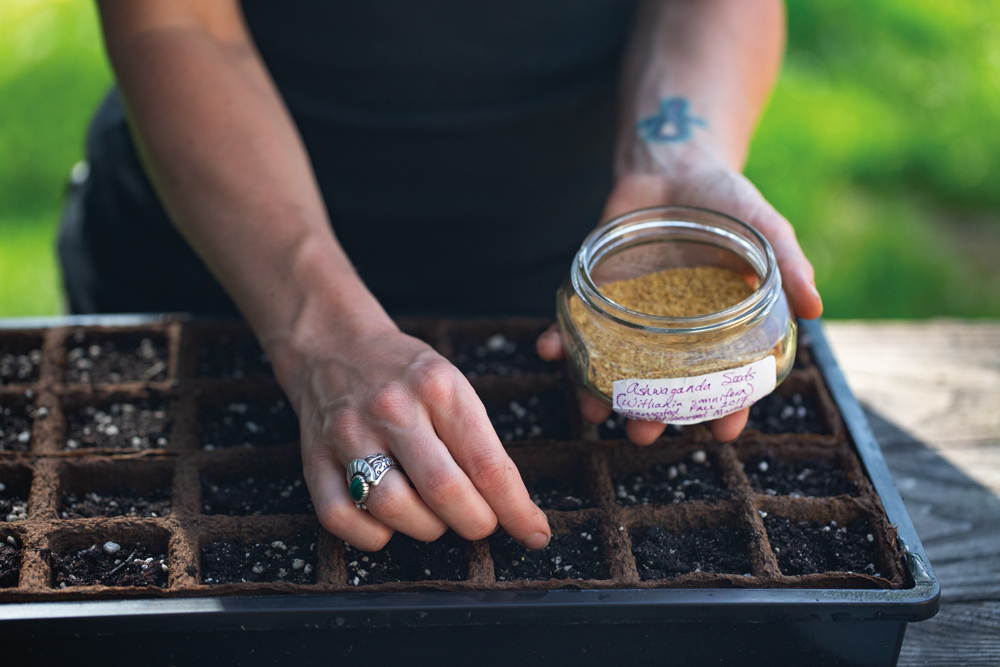
Surface sowing ashwagandha seeds.
How to Grow Ashwagandha
If you can grow tomatoes, you can likely grow a healthy harvest of ashwagandha, as these Solanaceae cousins prefer similar conditions in the garden. Ashwagandha loves heat, semi-arid soils, and an early indoor start to the season (in frost-prone areas).
Zones: 3-7 (grown as an annual); 8-13 (can be grown as a small, shrubby perennial)
Soil: Ashwagandha prefers warm, dry, well-drained soils and will even tolerate drought. It fares best in average garden soil (no need to pile on the compost) and will grow sizable roots in a single growing season throughout the temperate world.
Propagation: Ashwagandha is a light-dependent germinator, meaning its seeds require direct sunlight to sprout. Therefore, sow them on the surface of the soil and lightly tamp them in. The soils must be warm for germination to occur, so starting the seeds indoors or in a greenhouse (much as you would tomatoes) is helpful. Plus, you’ll get a leg up on the growing season, which can mean larger roots to harvest in the fall.
Siting and Garden Care: A warm-weather native, ashwagandha delights in sunshine. Plant in full sun, or select the brightest spot in your garden. If you grow lavender (Lavandula spp.) or rosemary (Salvia rosmarinus), ashwagandha will likely relish a place in their neighborhood.
Space plants 2 feet (0.6 m) apart and consider companion planting with herbs and flowers that deter pests. A few suggestions include marigolds (Tagetes spp.), nasturtiums (Tropaeolum majus), calendula (Calendula officinalis), thyme (Thymus vulgaris), and peppermint (mentha x piperita). In the case of mint, plant it in pots throughout the garden unless you’re ready to embrace its exuberant proclivity to spread.
In areas where ashwagandha grows as an annual (i.e., most places in the temperate world), try cultivating at least a few plants to obtain a good harvest. I often grow a dozen plants (or more) to feel confident of a robust supply and not fret if I lose a plant or two throughout the season.
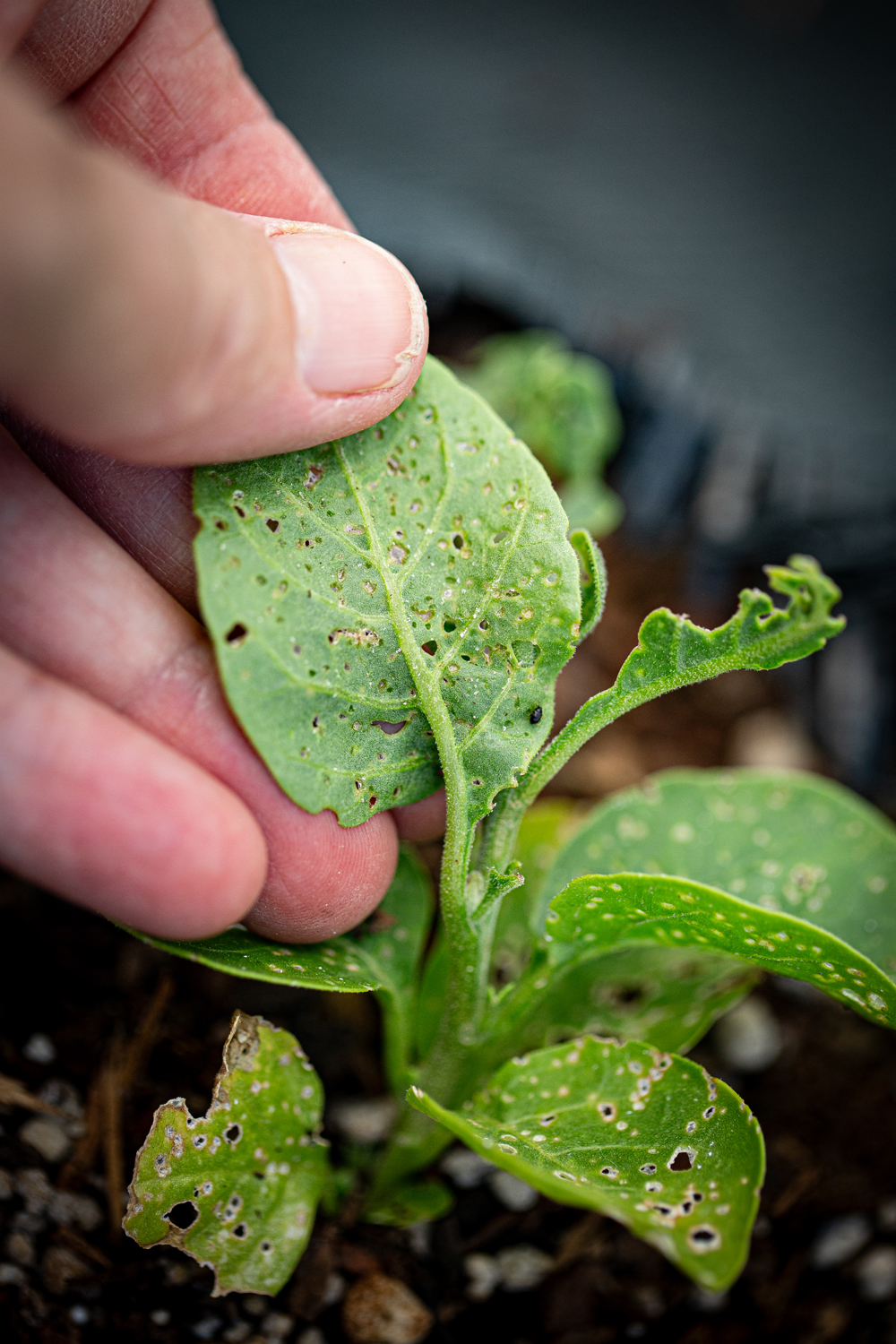
Ashwagandha eaten by flea beetles.
Problem Insects and Diseases: Flea beetles will be the bane of your ashwagandha’s existence if they’re a nuisance in your area. They feast willfully on the leaves and can cause the plants’ demise. Using row cover helps immensely, at least until the plants have reached a mature size. Alternately, wait until your ashwagandha starts are larger and hardier before transplanting them to the garden.
Harvesting: Dig ashwagandha roots in the fall before the first frost. Wash and chop the roots right away, spreading them on screens or loose-weave baskets to dry. Make sure to dry them in a warm, ventilated space out of direct sunlight.
Once dry, the roots can be stored, tinctured, or powdered. Note that the powder will degrade more quickly than the whole, chopped roots. Therefore, you may wish to powder ashwagandha in small batches, as needed.

Asia Suler holds a freshly harvested ashwagandha plant.
References
- Stansbury J. Herbal Formularies for Health Professionals, Volume 3: Endocrinology. Chelsea Green Publishing; 2018.
- Hoffman D. Medical Herbalism: The Science and Practice of Herbal Medicine. Inner Traditions/Bear & Co.; 2023.
- Sinadinos C. The Essential Guide to Western Botanical Medicine. Christa Sinadinos; 2020.
- Lad V, Frawley D. The Yoga of Herbs: An Ayurvedic Guide to Herbal Medicine. Lotus Press; 1986.
- Winston D, Maimes S. Adaptogens: Herbs for Strength, Stamina, and Stress Relief. Inner Traditions/Bear & Co.; 2007.
- Skenderi G. Herbal Vade Mecum. Herbacy Press; 2003.
- Dongre S, Deepak L, Sauvik B. “Efficacy and Safety of Ashwagandha (Withania somnifera) Root Extract in Improving Sexual Function in Women: A Pilot Study.” BioMed Res Intl. 2015.
- Mills S, Bone K. The Essential Guide to Herbal Safety. Elsevier Health Sciences; 2005.
Learn more about herbs with THE most comprehensive Online Herbalism Program on the planet.
We’ve designed our 1,000-hour Online Herbal Immersion with the truly passionate plant person in mind. It is THE most comprehensive online program in hands-on, sustainable herbalism that exists anywhere in the world.
The course curriculum is designed to help you succeed as a professional herbalist.
Are you ready to fall in love with herbs? The Immersion covers herbal materia medica, medicinal herb gardening, wild food and medicine foraging, medicine making, botany, plant I.D., healing histories, herbal career guidance, and more in 166 videos, 186 lessons, and a gorgeous 1,600-page printable course manual.
Meet The Green Mastermind Behind Blog Castanea

JULIET BLANKESPOOR is the founder, primary instructor, and Creative Director of the Chestnut School of Herbal Medicine, an online school serving thousands of students from around the globe. She's a professional plant-human matchmaker and bonafide plant geek, with a degree in botany and over 30 years of experience teaching and writing about herbalism, medicine making, and organic herb cultivation. Juliet’s lifelong captivation with medicinal weeds and herb gardening has birthed many botanical enterprises over the decades, including an herbal nursery and a farm-to-apothecary herbal products business.
These days, she channels her botanical obsession through her writing and photography in her online programs, on her personal blog Castanea, and in her new book, The Healing Garden: Cultivating and Handcrafting Herbal Remedies. Juliet and her family reside in a home overrun with houseplants and books in Asheville, North Carolina.
Interested in becoming a contributor?
© Chestnut School of Herbal Medicine and chestnutherbs.com, 2011-2025. Unauthorized use and/or duplication of this material without express and written permission from this site’s author and/or owner is strictly prohibited. Excerpts and links may be used, provided that full and clear credit is given to Chestnut School of Herbal Medicine and chestnutherbs.com with appropriate and specific direction to the original content.
The post The Medicinal Benefits of Ashwagandha appeared first on Chestnut School of Herbal Medicine.
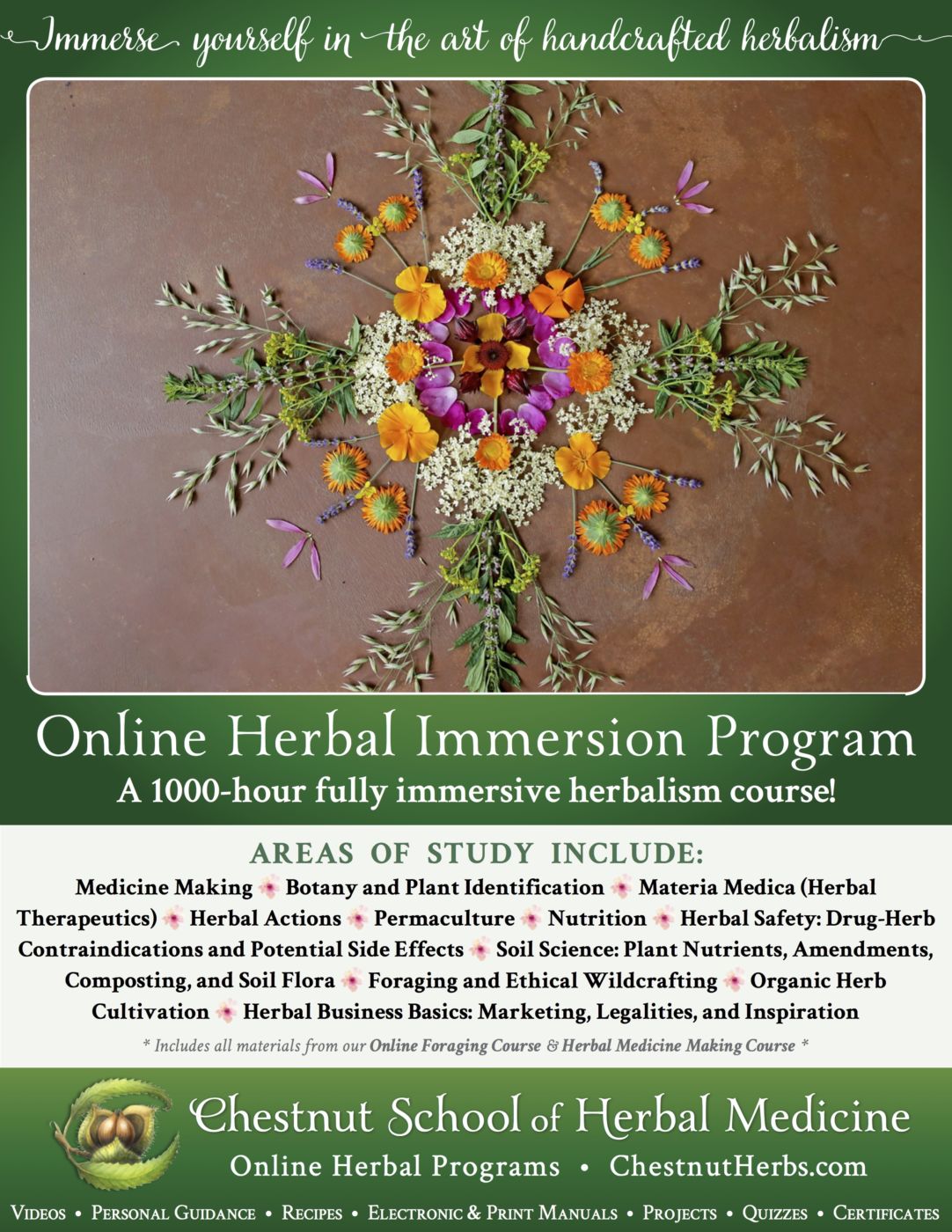
Leave a Reply